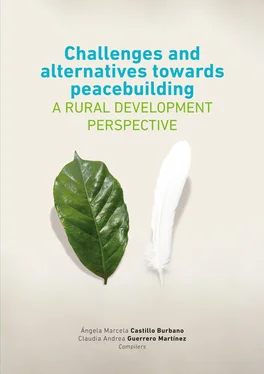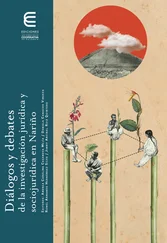This was reflected in the signing of the first ceasefire agreement with the FARC-EP, the M-19 and the EPL, as well as in the creation of the “Unión Patriótica” or “Patriotic Union” as a political party. However, the breach of the agreements by the Government, the absence of guarantees to exercise a political opposition, the continuous attacks on the civilian population and the actions of the paramilitary groups, resulted in the signed agreements not culminating satisfactorily (García-Durán, 2010). Despite this, the Betancur period laid the foundations for future negotiations, helping to change perceptions about the guerrilla problem and the need to articulate dialogue with reforms (López, 1999, p. 250).
For its part, the government of Virgilio Barco adhered to the “outstretched and firm hand” formula, a strategy oriented both towards negotiations with guerrilla movements and to actions to counteract the objective causes of violence (López, 1999, p. 250). Its mandate was marked by the creation of the Coordinadora Guerrillera Simón Bolívar, made up of the FARC, ELN, M-19, PRT and the Quintín Lame movement, which aimed to unify the guerrilla movement in its political, military and organizational aspects to design a road map for the signing of a peace agreement. However, this initiative failed to consolidate, because years later the M-19 and part of the EPL signed a peace agreement with the Government with the other guerrilla groups being left out of that agreement.
The nineties, with an air of renewal derived from the “Asamblea Nacional Constituyente” or “National Constituent Assembly” and the transition to the “Estado Social de Derecho” or “Social State of Law”, was characterized by two scenarios: one, featuring various negotiations and demobilizations of armed actors and, the other, marked with the intensifying of the armed struggle and increased levels of military persecution by the State. Among the various negotiations and pacts of this stage, some of the more notable include the signing of peace agreements with: the PRT, the Armed Indigenous Movement “Quintín Lame”, a fraction of the ELN and another part of the EPL. There were also peace negotiations, albeit fruitless, with the Simón Bolívar Guerrilla Coordinating Board in Tlaxcala, Mexico, during the presidential term of César Gaviria and with the ELN and EPL during the term of Ernesto Samper. With Andrés Pastrana, new formal negotiations were initiated with the FARC in the Caguán peace process, as will be seen below. In the first decade of the 21st century, the dialogues with the armed groups took a new direction, as approaches and negotiations during the administration of Álvaro Uribe were held with paramilitary groups instead of with the still active guerrilla movements –mainly the FARC-EP and ELN–. As a result of this process, the Ralito Agreement was consolidated, which achieved the demobilization of several paramilitary structures.
Peacebuilding in Colombia
After more than half a century of armed confrontation and failed negotiations with the FARC-EP, a new process has been initiated in Colombia, aimed at building a stable and lasting peace involving structural reforms not addressed in previous processes. It is therefore essential to articulate the transitional justice mechanisms proposed in the Peace Agreement together with the existing state institutions. The successful implementation of the Agreement, which will surely be complicated and extensive, will depend to a large extent on ensuring the realization of the rights afforded to the victims of the armed conflict.
Transitional justice processes
The transition from war to peace is a complex process, especially in countries where, like Colombia, the armed conflict has been ongoing for such an extensive period of time. Transitional justice processes are those:
through which radical transformations of a social and political order are made; either by the passage of a dictatorial regime to a democratic one, or by the end of an internal armed conflict and the achievement of peace. Transitional justice processes encounter important dilemmas, all originating in the complex need to balance the conflicting objectives of justice and peace. (Uprimny, 2006, p. 13).
In his report “The rule of law and transitional justice in societies that suffer or have suffered conflicts”, the Secretary General of the United Nations defined transitional justice as,
the full range of processes and mechanisms associated with a society’s attempts to come to terms with a legacy of large-scale past abuses, in order to ensure accountability, serve justice and achieve reconciliation. These may include both judicial and non-judicial mechanisms, with differing levels of international involvement (or none at all) and individual prosecutions, reparations, truth-seeking, institutional reform, vetting and dismissals, or a combination thereof. (ONU, doc. S/2004/616, 2004, para. 8).
Thus, transitional justice is not a special form of justice, but a strategy –composed of multiple mechanisms– for the realization of the rights to justice, truth, reparation and guarantees of non-repetition in a context of serious violations of human rights and International Humanitarian Law.
The United Nations Special Rapporteur, on the promotion of truth, justice, reparation and guarantees of non-recurrence, stated that the areas of action that make up transitional justice all serve the ultimate end of pursuing justice, which in a less abstract functional analysis implies the achievement of two mediate goals: providing recognition to victims and fostering trust; and two final goals: contributing to reconciliation and strengthening the rule of law (ONU, doc. A/HRC/21/46, 2012, para. 21).
For such purposes there is no definitive model of transitional justice, but, according to internationally established norms, each State adopts its own according to its context, particularities and needs. What transitional justice processes do have in common, especially in their most recent developments, is a transformative vocation, since they aspire to be one of the basic mechanisms to guarantee the construction of a stable and lasting peace on the basis of respect and guaranteeing the rights of the victims. Therefore, our Constitutional Court has recognized the importance of weighing the obligations and rights of the State in a transitional justice process,
in order to achieve a balance between constitutional rights to justice and peace, with the understanding that neither is absolute and that, in transnational justice contexts, the right to justice can be modulated to harmonize it with the effectiveness of other rights and the fulfillment of the duties of the State, such as peace, reparation for victims or the attainment of the truth. (Corte Constitucional, 2014).
The Peace Agreement with the FARC-EP
After the demobilization of some of the guerrilla groups, such as the M-19, and except for some redoubts of former insurrection movements, only the two strongest guerrilla groups have remained active in recent years: the FARC and the ELN.
The FARC-EP, which was born in 1964 as an insurgent group of campesino origin with the purpose of accessing power through the revolution, intensified its methods and means of combat over the years, until it became a large military structure with an increasingly offensive focus. There were two firm attempts to achieve a negotiated peace between the FARC and the State before reaching the final agreement. The first, in 1984, with the signing of a ceasefire with President Belisario Betancur. The second, known as the Caguán peace process, began in 1998 with President Andrés Pastrana, and consisted of a failed negotiation without a ceasefire.
In 2012, after a phase of exploratory dialogues, President Juan Manuel Santos and the FARC announced the beginning of a new peace process. During several years of formal negotiations in Havana, the different points of an agenda, established under the principle that “nothing is agreed until everything is agreed”, were discussed. On September 26th, 2016, the Government of Colombia and the FARC-EP signed the Final Peace Agreement. However, this agreement was rejected on October 2nd in the referendum convened by the Government for its endorsement. The two negotiating parties readjusted several sections of the text in order to obtain a new agreement, which was signed on November 24th of the same year. Next, the “Congreso de la República” or “Congress of the Republic” endorsed the definitive agreement or the “Acuerdo Final para la Terminación del Conflicto y la Construcción de una Paz Estable y Duradera”.
Читать дальше












